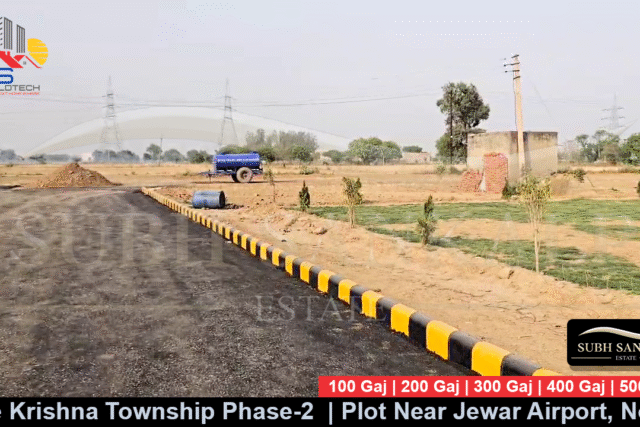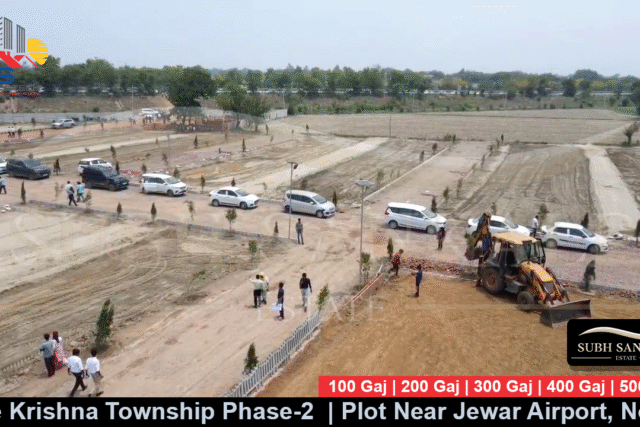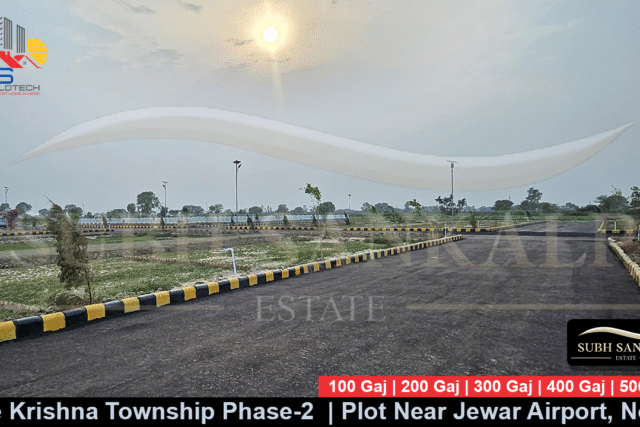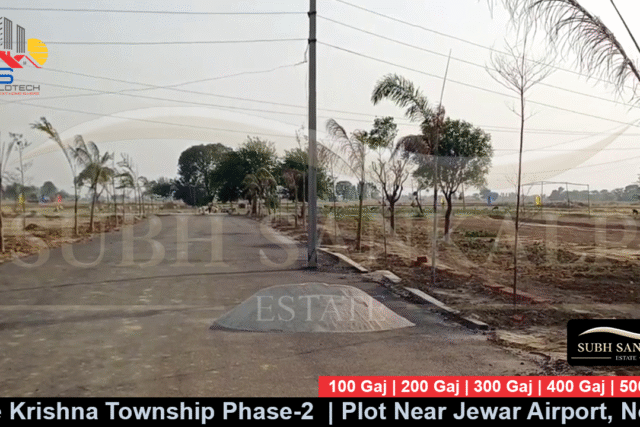The development of the Noida International Airport at Jewar is catalyzing one of the most significant urban transformations in the Delhi-NCR region. While various plot sizes are available, the 300 Gaj Jewar Airport Ke Pass Plot – Hare Krishna Township Phase 2 stands out as a premium asset class, catering to investors and buyers with a vision for substantial legacy wealth and luxurious end-use. This isn’t just a plot of land; it’s a canvas for a grand villa, a strategic long-term holding, or a future institutional site. This guide provides a comprehensive overview of investing in a 300 Gaj plot in this high-stakes real estate arena.
1. Grasping the Magnitude: The Scale of a 300 Gaj Plot
A 300 Gaj plot represents a significant landholding. It is equivalent to 300 square yards or approximately 2,700 square feet (250.8 square meters). This expansive size places it in a league distinct from smaller residential plots. It offers unparalleled freedom for architectural design, allowing for a sprawling villa with extensive landscaping, multiple recreational areas, and premium amenities like a private pool or a large courtyard, all within a secure boundary.
2. The Unbeatable Location: Jewar Airport’s Influence
The core value proposition is the plot’s location within the planned sectors of the Yamuna Expressway Industrial Development Authority (YEIDA), close to the airport boundary.
- Strategic Proximity: Plots within a 5-7 km radius of the airport are considered the “golden zone,” offering a balance between direct access and a peaceful residential environment, free from the immediate noise and congestion of the terminal.
- Master-Planned Infrastructure: Investing in a YEIDA sector ensures access to world-class infrastructure—wide, sectorial roads, underground utilities, dedicated water supply, and lush green belts. This planned development ensures that your premium investment is set within a premium neighborhood.
- Multi-Modal Connectivity: The synergy between the Yamuna Expressway, the proposed Film City, the dedicated freight corridor, and future metro links makes this location irreplaceable and ensures long-term value appreciation.
3. The Investment Thesis: The Case for a 300 Gaj Plot
- Elite Appreciation Potential: The law of scarcity applies directly to real estate. Large, premium plots in a high-growth zone are the first to become scarce and see exponential value growth. A 300 Gaj plot is a blue-chip asset that is likely to outperform the market average in terms of percentage appreciation.
- Ultimate End-Use Flexibility: This size is perfect for constructing a legacy home—a large, single-family villa that can accommodate multiple generations. Alternatively, it presents an opportunity for high-end boutique ventures, such as a guesthouse, a corporate retreat, or a specialty clinic, catering to the affluent demographic that the airport and its ancillary units will attract.
- A Hedge Against Inflation: In volatile economic times, substantial land assets in irreplaceable locations act as a powerful hedge against inflation. The tangible nature of the asset, combined with the macro-economic tailwinds of the airport project, provides exceptional security for your capital.
4. The Acquisition Process: Navigating the Market
- YEIDA Allotments: The most secure, though highly competitive, route is through official YEIDA ballots. These plots come with the strongest titles but are subject to a lock-in period, preventing immediate resale.
- Private Developer Projects: Reputed developers are offering 300 Gaj plots in gated communities with premium amenities. This route often provides more flexibility and immediate possession.
- Imperative Due Diligence: For an investment of this scale, due diligence is non-negotiable. This includes:
- Title Verification: A thorough check of the title chain for several decades.
- Authority Approvals: Confirming YEIDA or BDA approval for the layout and land use.
- RERA Registration: Ensuring the project is registered under RERA for buyer protection.
- Encumbrance Certificate: Verifying the land is free from any legal or financial dues.
5. Market Outlook and the Aerotropolis Vision
The market for 300 Gaj plots is driven by high-net-worth individuals and institutional investors.
- Pricing Spectrum: As a premium product, prices are at the higher end of the spectrum, often ranging from ₹ 25,000 to ₹ 60,000+ per square yard, heavily influenced by the exact location, frontage, and developer reputation.
- Beyond the Runway: The investment is in the “Aerotropolis”—the urban ecosystem that evolves around a major airport. This includes MRO (Maintenance, Repair, and Overhaul) facilities, international conference centers, luxury hotels, and global corporate offices. This diversified economic base guarantees a sustained demand for exclusive residential and commercial spaces, ensuring your 300 Gaj plot remains a coveted asset.
1. What makes a 300 Gaj plot a better investment than a smaller one?
While smaller plots are more liquid, a 300 Gaj plot offers superior appreciation potential due to its scarcity and appeal to a wealthier clientele. It allows for a more substantial and valuable end-product (e.g., a luxury villa), which typically yields a higher return on investment both in capital gains and, if rented, in rental income.
2. Can I build a farmhouse on a 300 Gaj plot?
While the term “farmhouse” often implies agricultural land, a 300 Gaj plot in a YEIDA residential sector is meant for a residential villa. However, you can certainly design your villa with extensive landscaping, a kitchen garden, and open spaces to emulate the ambience of a farmhouse, while complying with residential building bylaws.
3. What is the typical construction cost to build a villa on a 300 Gaj plot?
Construction costs vary based on the quality of finishes. As a rough estimate, with current rates, building a good quality villa could cost between ₹ 2,000 to ₹ 3,500 per square foot. For a 2,700 sq ft plot (with a build-up area of, for example, 4,000 sq ft across two floors), the total cost could range from ₹ 80 lakhs to over ₹ 1.4 crores, excluding the cost of the land.
4. Are there any specific tax implications for owning a large plot?
Yes. While the purchase attracts stamp duty and registration charges, holding a large plot has implications for Property Tax (to the authority) and Income Tax. If the property is not used for self-occupation, Notional Rent may be considered for taxation. It is highly advised to consult a chartered accountant for personalized advice.
5. Is financing available for the purchase and construction?
Yes, most banks and NBFCs offer plot loans (for purchase) and separate home construction loans. However, loan-to-value (LTV) ratios for plot purchases are typically lower (50-70%) than for ready-to-build houses. For a seamless process, it’s best to discuss your entire plan—plot purchase plus construction—with your financial institution.
















Leave a review for 300 Gaj Jewar Airport Ke Pass Plot – Hare Krishna Township Phase 2